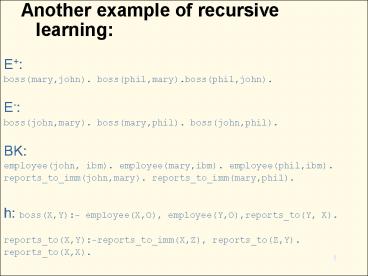E : - PowerPoint PPT Presentation
1 / 12
Title: E :
1
Another example of recursive learning
- E
- boss(mary,john). boss(phil,mary).boss(phil,john).
- E-
- boss(john,mary). boss(mary,phil).
boss(john,phil). - BK
- employee(john, ibm). employee(mary,ibm).
employee(phil,ibm). - reports_to_imm(john,mary). reports_to_imm(mary,phi
l). - h boss(X,Y)- employee(X,O), employee(Y,O),report
s_to(Y, X). - reports_to(X,Y)-reports_to_imm(X,Z),
reports_to(Z,Y). - reports_to(X,X).
2
How is learning done covering algorithm
- Initialize the training set T to all k-tuples of
constants while the global training set
contains tuples
find a clause that describes part of
relationship Q remove the tuples covered
by this clause - Finding a clause
- initialize the clause to Q(V1,Vk) -
while T contains tuples
find a literal L to add to the right-hand side
of the clause
- Finding a literal greedy search
3
- Find a clause loop describes search bottom
up or top down - Need to structure the search space
- generality semantic and syntactic
- since logical generality is not decidable, a
stronger property of ?-subsumption - then search from general to specific (refinement)
4
Refinement
Heuristics link to head new variables
boss(X,Y)-
boss(X,Y)-empl(X,O).
boss(X,Y)-XY
boss(X,Y)-reports_to(X,Y).
boss(X,Y)-empl(X,O),empl(Y,O1).
boss(X,Y)-empl(X,O),empl(Y,O).
boss(X,Y)-empl(X,O),empl(Y,O),rep_to(Y,X).
boss(X,Y)-empl(X,O),empl(Y,O),rep_to(X,Y).
5
How is learning done covering algorithm
- Inner loop describes search bottom up and top
down - we do the latter - Need to structure the search space generality
semantic and syntactic theta subs.
6
Constructive learning
- Do we really learn something new?
- Hypotheses are in the same language as examples
- constructive induction
- How do we learn multiplication from examples? We
need to invent plus we have shown IJCAI93 that
true constructivism requires recursion, i.e. in - mult(X,s(Y),Z) - mult(X,Y,T), newp(T,Y,Z)
- mult(X,0) - 0.
- Newp plus - must be recursive.
7
Philosophical motivation
- Constructive induction is analogical to
revolution in the methodology of science - Kuhns Structure of Scientific Revolution
- normal science -gt crisis -gt revolution -gt normal
science - Normal science learning a theory in a fixed
language - Crisis failure to cope with anomalies observed,
due to inadequate language - Revolution introduction of new terms into the
language (cannot be done in AV)
8
Example predicting colour in flowers
- Language r, y a is any red flower, b is any
yellow flower col(X,Y) X is of colour Y ch(X,Y)
result of breeding of X and Y - Observations (that Czech monk and his peas)
- col(a,r) Adam and Eve
- col(b,y).
- col(ch(a,a),r). first generation
- col(ch(a,b),r).
- col(ch(b,b),b).
- col(ch(a,ch(b,b),r).original and 1st
- col(ch(ch(a,b)ch(a,b),y). 1st and 1st
- .
- -col(ch(a,a),y).
9
- col(ch(a,X),r).
- col(ch(X,Y),a) - col(X,r), col(Y,r).
- col(ch(b,b),y).
- col(ch(X,Y), y) - col(X,y),col(Y,y).
- But in some generations y and r produce r, and in
some y - We need either infinitely many clauses, or
infinitely long clauses - A revolution is necessary
10
A new necessary predicate is invented
- n00 represents purebred flowers with recessive
character, n11 with dominant, and n10 hybrid
with dominant - In fact, the invented predicates represent the
concept of a gene!
11
Success story mutagenicity
- heterogeneous chemical compounds their
structure requires relational representation - BK properties of specific atoms and bonds
between them (relation!) and generic organic
chemistry info (e.g. structure of benzene rings,
etc.) - Regression-unfriendly
- A learned rule has been published in Science
conjugated double bond in a five-member ring
12
problems
- Expressivity efficiency
- Dimensionality reduction
- Therefore, interest in feature selection

